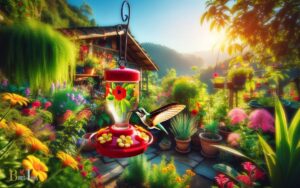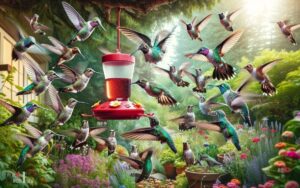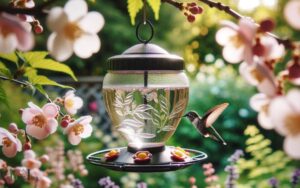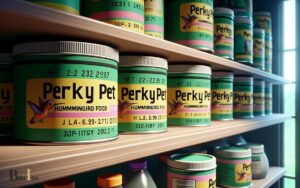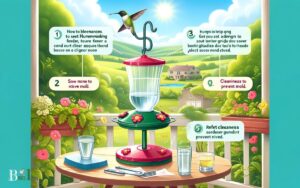Do Bees Eat Hummingbird Food? Yes!
Yes, bees do eat hummingbird food. They are attracted to the sugar-water solution commonly used in hummingbird feeders as it mimics natural nectar.
Bees, like hummingbirds, seek out nectar as a source of energy. Hummingbird food, typically a sugar-water mixture, closely resembles the nectar found in flowers which both hummingbirds and bees are naturally drawn to.
This can lead to bees frequenting hummingbird feeders for an easy food source.
Here are some key points:
- Both bees and hummingbirds are attracted to sweet liquids.
- Sugar-water used in hummingbird feeders is similar to floral nectar.
- Bees may crowd feeders, making it difficult for hummingbirds to access the food.
Ensure a peaceful coexistence between bees and hummingbirds with proper feeder management and bee-friendly garden practices.
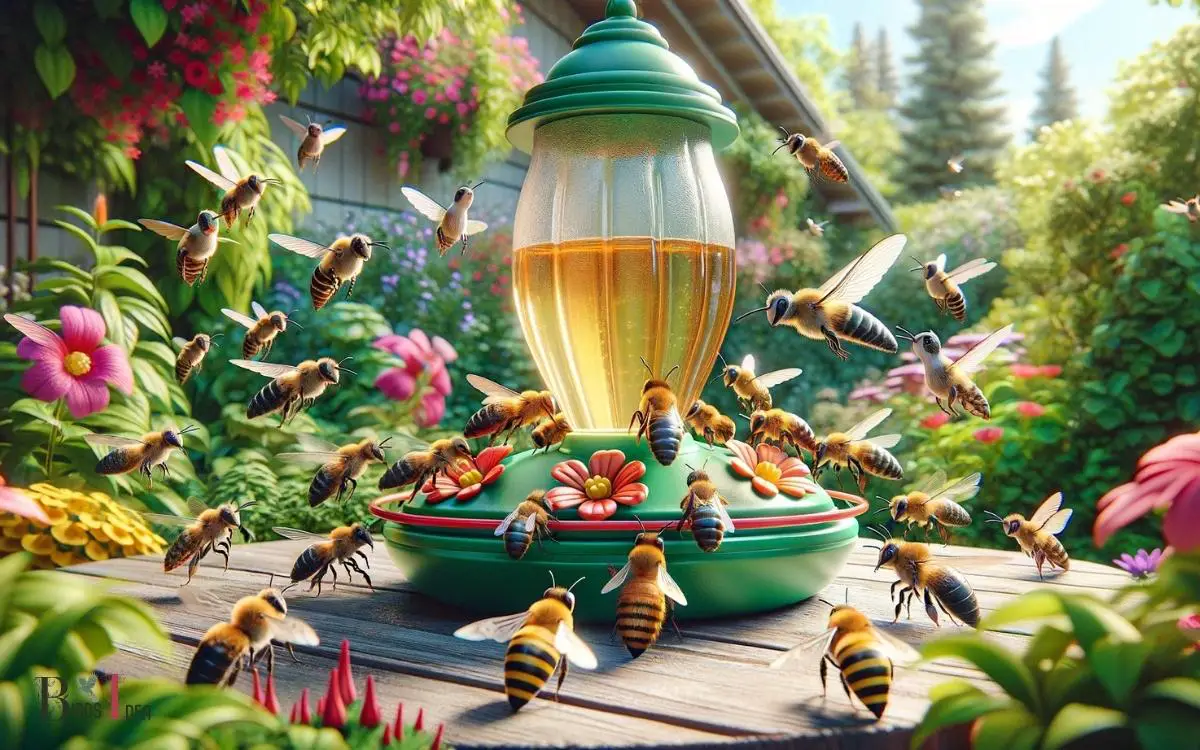
Key Takeaway
The Components of Hummingbird Food
While bees are attracted to the sweetness of hummingbird food, it is essential to understand the components that make up this nourishment for our avian friends. Hummingbird food primarily consists of a simple mixture of sugar and water.
The ideal ratio for hummingbird food is four parts water to one part sugar, as this closely resembles the sucrose levels found in natural nectar.
It is crucial to use plain, white, granulated sugar, as substitutes like honey can promote the growth of harmful microorganisms.
Red dye, often used to attract hummingbirds, is unnecessary and potentially harmful, so it is best avoided.
Providing clean, fresh hummingbird food is essential for the health and well-being of these delightful creatures, as it fuels their high metabolic rate and energetic lifestyle.
Bee Attraction to Sweet Nectar
Bees are known for their strong attraction to sweet nectar, making them important pollinators for many flowering plants.
The foraging behavior of bees for nectar is a crucial aspect of their ecological role in maintaining plant biodiversity.
The sweetness of nectar is a key factor that draws bees to flowers, and understanding this attraction can help in creating bee-friendly environments through the cultivation of nectar-rich plants.
Bee Nectar Foraging
Attracted to the sweet nectar produced by flowers, bees play a crucial role in pollination and the ecosystem.
Bees forage for nectar as their primary source of energy, collecting it to take back to their hives for storage as honey.
During nectar foraging, bees inadvertently transfer pollen from one flower to another, facilitating the reproduction of flowering plants.
The table below highlights the key factors that attract bees to nectar-rich flowers:
| Factors | Description | Importance |
|---|---|---|
| Color of flowers | Bees are attracted to bright colors, especially | High |
| shades of blue, purple, and yellow. | ||
| Aroma of nectar | Bees are drawn to the scent of sweet nectar. | Medium |
| Nectar volume | Flowers with larger nectar volumes are preferred | High |
| by bees. | ||
| Nectar quality | Bees prefer nectar with higher sugar content. | High |
Understanding the factors that attract bees to nectar-rich flowers can aid in creating bee-friendly environments and promoting pollination.
Sweetness Attracts Bees
Drawing upon the factors that attract bees to nectar-rich flowers, the presence of sweetness is a significant determinant in bee foraging behavior.
Bees are naturally attracted to sweet nectar due to their reliance on it as a primary source of energy.
The sweetness of nectar is attributed to the presence of sugars, predominantly sucrose, glucose, and fructose, which serve as a vital energy source for bees.
This attraction to sweet substances is an evolutionary adaptation that has allowed bees to efficiently gather energy for their hives.
The sweetness of nectar also serves as a signal to bees, indicating the presence of a viable food source.
This signal triggers foraging behavior and guides bees to the nectar-rich flowers, ultimately facilitating the pollination process.
Therefore, the sweetness of nectar plays a crucial role in attracting bees and promoting their foraging activities.
Bee-Friendly Nectar Plants
The presence of sweetness in nectar-rich flowers serves as a significant determinant in bee foraging behavior, guiding them towards bee-friendly nectar plants.
- Nectar-Rich Flowers: Bees are attracted to flowers with high nectar production, such as bee balm, lavender, and sage.
- Color and Shape: Bees are drawn to bright-colored flowers, particularly blue, purple, and yellow blooms, as well as tubular or trumpet-shaped flowers that allow easy access to nectar.
- Continuous Bloom: Plants that provide a consistent nectar supply throughout the growing season, like coneflowers and black-eyed Susans, are highly attractive to bees.
- Native Plant Species: Bees show a preference for native plant species, like sunflowers and goldenrod, as they have co-evolved with these plants and are well-adapted to their nectar production.
Bee Behavior Around Hummingbird Feeders
Bees are often drawn to hummingbird feeders due to the presence of sweet nectar, which they are capable of detecting from a significant distance.
When bees find a hummingbird feeder, they tend to hover around the feeding ports, making it difficult for hummingbirds to access the nectar.
Bees can become aggressive in defending the nectar source, further deterring hummingbirds from feeding.
The presence of bees can lead to a decrease in hummingbird visits to the feeder, impacting the ability of these birds to obtain the necessary nutrients for their survival.
To mitigate the impact of bees on hummingbird feeding, it is essential to understand their behavior and implement strategies to minimize their presence around the feeders.
Transition: Understanding the impact of bees on hummingbird feeding is crucial for effectively addressing this issue and ensuring the well-being of these fascinating birds.
Impact of Bees on Hummingbird Feeding
The presence of bees around hummingbird feeders significantly impedes the ability of hummingbirds to access the nectar, ultimately impacting their feeding behavior and nutritional intake.
This interference can have detrimental effects on hummingbird populations and their ability to thrive.
The impact of bees on hummingbird feeding is a crucial consideration for individuals who seek to support the well-being of these delicate birds.
Here are four key points to understand the impact of bees on hummingbird feeding:
- Competition for Nectar: Bees can outcompete hummingbirds for access to the nectar, leading to reduced feeding opportunities for the birds.
- Feeding Disruption: The presence of bees can disrupt hummingbirds’ feeding patterns, causing them stress and potential malnutrition.
- Decreased Nectar Consumption: Hummingbirds may consume less nectar when bees are present, affecting their energy levels and overall health.
- Habitat Avoidance: Persistent bee presence may lead hummingbirds to avoid feeding areas, impacting their foraging behavior and potentially affecting their breeding success.
Ways to Deter Bees From Hummingbird Feeders
To minimize bee interference at hummingbird feeders, it is essential to consider bee-friendly feeder designs, such as those with built-in bee guards or feeding ports that are too small for bees to access.
Natural bee deterrents like peppermint oil or cinnamon can be strategically placed near the feeders to discourage bees.
Proper maintenance, including keeping the feeders clean and free of drips or leaks, can also help minimize bee attraction to the sweet nectar.
Bee-Friendly Feeder Designs
Designing hummingbird feeders with bee-deterring features is essential for maintaining a peaceful coexistence between hummingbirds and bees.
To achieve this, consider the following bee-friendly feeder designs:
- Bee guards: Install bee guards or barriers around the feeding ports to prevent bees from accessing the nectar.
- Perchless feeders: Opt for feeder designs that lack perches as bees are less likely to hover around feeders without perches.
- Reducing the drip: Choose feeders with built-in mechanisms to minimize nectar leakage, as excess nectar can attract bees.
- Locating strategically: Place the feeders in shaded areas or use bee-repelling scents around the feeders to deter bees from approaching.
Natural Bee Deterrents
Implementing natural bee deterrents is essential for maintaining a peaceful coexistence between hummingbirds and bees around feeders.
One effective method is to plant bee-repelling flowers such as marigolds, mint, or geraniums near the feeding area.
These plants emit scents that deter bees while attracting hummingbirds. Another natural deterrent is the use of essential oils such as peppermint or cinnamon.
These oils can be diluted and sprayed around the feeder to repel bees without harming the hummingbirds.
Providing a separate feeding station for bees with a mixture of water and sugar away from the hummingbird feeder can redirect their attention.
Regular maintenance of feeders to prevent spills and leaks will also help deter bees, as they are attracted to the scent of sugary spills.
These natural deterrents can create a harmonious environment for both hummingbirds and bees.
Proper Feeder Maintenance
Proper maintenance of hummingbird feeders is crucial for minimizing bee presence and ensuring a peaceful coexistence between hummingbirds and bees in the feeding area.
To deter bees from hummingbird feeders, it’s essential to follow these maintenance practices:
- Regular Cleaning: Clean the feeders thoroughly with hot water and mild soap at least once a week to remove any residual sugar or nectar that may attract bees.
- Leak Prevention: Ensure that the feeder is not leaking or dripping, as this can attract bees. Check for any cracks or damage that may cause leaks.
- Strategic Placement: Hang the feeder in a location that is not frequented by bees, such as in the shade or near a water source that hummingbirds prefer.
- Use Bee Guards: Consider using feeders with built-in bee guards or add-on bee guards to prevent bees from accessing the feeding ports.
Can Bees Compete with Hummingbirds for Food?
Can bees compete with hummingbirds for food? While bees are equally agile pollinators, the hummingbirds’ visual acuity uncovers food sources that may go unnoticed by their insect counterparts. With their sharp vision and ability to detect vibrant colors, hummingbirds easily locate nectar-rich flowers, maintaining their competitive edge when it comes to food acquisition.
Balancing Bee and Hummingbird Presence
To achieve a balanced coexistence, both bees and hummingbirds require a diverse array of nectar sources in the environment.
Maintaining a harmonious relationship between bees and hummingbirds in a shared habitat is essential for supporting their respective needs.
Here are four key strategies for achieving a balanced presence of bees and hummingbirds:
- Plant a variety of nectar-rich flowers that bloom at different times to ensure a continuous nectar supply throughout the year.
- Provide separate feeding areas for bees and hummingbirds to minimize competition for nectar.
- Avoid using pesticides and herbicides that can harm both bees and hummingbirds.
- Install bee-friendly and hummingbird-friendly feeders in different locations to cater to the specific feeding behaviors of each species.
Conclusion
Bees are attracted to the sweet nectar in hummingbird food, which can impact hummingbird feeding.
However, by implementing strategies to deter bees from feeders and creating a bee-friendly habitat, it is possible to strike a balance between bee and hummingbird presence.
While some may argue that bees should be allowed to access the nectar, it is important to prioritize the needs of hummingbirds and take steps to minimize bee interference.

